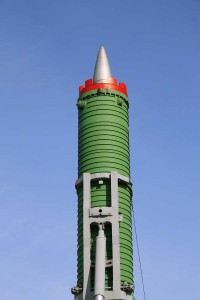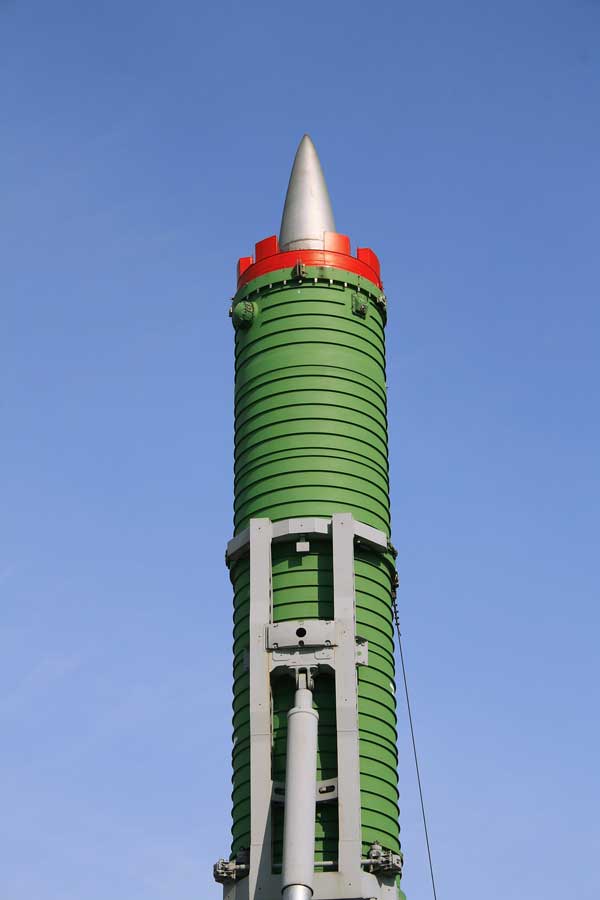
12/14/2011 – Ten years ago this week, the United States gave the Russian Federation formal notice that Washington would withdrawal from the Anti-Ballistic Missile (ABM) Treaty. It was originally signed between the United States and the Soviet Union on May 26, 1972, by President Richard Nixon and Leonid Brezhnev , the General Secretary of the Communist Party of the Soviet Union. At the time, both sides’ strategic offensive nuclear weapons were so numerous and powerful, and ballistic missile defense (BMD) technology so undeveloped, expensive, and ineffective, that both governments decided to cease major work on BMD systems.
The world changed in the subsequent three decades. The Cold War ended, new BMD technologies were developed, and after 9/11 the United States was no longer willing to deny itself any possible means of defense. The George W. Bush administration decided to exercise its right to withdraw from the ABM Treaty in accordance with the treaty clause that allowed for such withdrawal with six months’ notice if a country felt its supreme national interests required such a move. The withdrawal took effect in June 2002.
The move was controversial. It marked the first time that the United States had formally withdrawn from a major international arms control treaty. Some concerned analysts predicted the withdrawal would lead to the end of other treaties and the demise of the nuclear nonproliferation regime. But the Russian government reacted fairly calmly. Then President Vladimir Putin said Moscow considered the withdrawal a mistake, but would continue to work with Washington on arms control and in collaborating against the new threat of international terrorism. Even before the treaty withdrawal took effect, Russia and the United States signed a new Strategic Offensive Reductions Treaty in Moscow on May 24, 2002.

But, as is often the case, arms control treaties require a benign international environment to work best. When the security environment turns nasty, arms control and other defense constraints are quickly forgotten.
This is what happened with missile defense. When Russian –U.S. relations deteriorated a few years later, the Russians resumed demands that the United States limit its BMD activities, ideally through a new formal arms control agreement to replace the ABM Treaty. The United States resisted.
This period offers helpful lessons for today’s negotiators. At first, Bush administration officials believed that their Russian counterparts genuinely, if erroneously, felt threatened by the planned deployment of U.S. BMD systems. They responded by launching a comprehensive campaign to convince their Russian colleagues that these systems aimed only to counter an emerging Iranian missile threat and, due to their limited number and capabilities, could in no way threaten Russia.
As Russian opposition continued, however, U.S. officials became convinced that Russian leaders objected to the BMD deployments even though they actually understood that the planned systems could not threaten Russia’s large ICBM arsenal. U.S. observers began to emphasize other reasons for Russian objections to the deployment.
For example, some U.S. analysts speculated that the displays of saber rattling aimed to justify increases in Russian defense spending and mobilize nationalist forces behind the Putin regime. They also perceived Russian protests over European BMD as motivated partly by Russian objections to NATO’s continued enlargement into former Soviet territories, with the Russians reacting to the BMD issue as the most tangible symbol of NATO’s unwelcome penetration into former Soviet-controlled territories. Senior ministers of the governments of Poland and the Czech Republic, the two countries that had committed to hosting the U.S. BMD systems under the Bush administration, also characterized Russia’s hostile reaction as an attempt to establish that their countries still fell within Moscow’s sphere of influence.
For their part, Russian officials complained that the briefings U.S. officials gave on the proposed BMD deployments were insufficiently comprehensive or detailed—a problem that would need to be overcome in any effort to pursue comprehensive NATO-Russian BMD collaboration in the future. Russian analysts also expressed concerns about the open-ended nature of the evolving U.S. global BMD architecture. Although Russian defense experts acknowledge that their country’s vast strategic missile arsenal could easily overwhelm the small number of interceptor missiles planned for Poland, they claimed that the United States, unconstrained by a formal treaty, could deploy additional BMD systems in the future.
Throughout 2007 and 2008, Russian and American officials discussed a number of U.S. proposals to mitigate Moscow’s security concerns regarding the planned BMD deployments in Poland and the Czech Republic. In particular, they offered a series of confidence-building measures (CBMs) that would increase the transparency of the BMD facilities’ operations to the Russian government as well as limit any theoretical threat they might pose to Russia’s own nuclear missile arsenal. Future attempts to establish a BMD system near the Russian Federation in the Persian Gulf or elsewhere might also require CBMs, but the earlier frustrating experience is not encouraging.
Among their proposed CBMs, U.S. officials suggested that, with the approval of the Czech and Polish governments, Russian personnel might inspect operations at the U.S.-run BMD facilities on these countries’ territories. They also offered to give Russian inspectors access to BMD sites on U.S. territory. In addition, Secretary Gates said that the United States would not “operationalize the sites until we had had flight testing from Iran that showed a capability to threaten Europe.” American officials further indicated they would negotiate limits on Washington’s missile deployments at the sites to overcome Moscow’s worries about “a breakout,” during which the United States might vastly increase its BMD systems near Russia. U.S. negotiators also reviewed possible constraints on the capabilities and operation of the BMD systems to reduce the possible threat they could pose to Russia’s own strategic nuclear missiles.
These offers never succeeded in making Russian leaders comfortable with the planned deployments. Russian Foreign Minister Sergey Lavrov continued to argue in favor of Moscow’s alternative proposal to establish some kind of joint U.S.-NATO-Russian BMD architecture for Europe, observing that, while Moscow was willing to negotiate, Russian policy makers nevertheless remained “convinced that the best way to assuage Russia’s concerns … will be to abandon such plans and turn to a truly collective project.”
Lavrov was referring to various Russian proposals made by Putin to share data with Washington from the Russian-operated early warning radars located at Gabala in Azerbaijan and Armavir in Russia’s North Caucasus. At the June 2007 G-8 summit in Germany, Putin offered to provide the United States with unprecedented access to intelligence on Iranian missile developments from the Russian-leased Gabala radar station in return for Washington’s promise to freeze its planned Czech and Polish deployments. At the July 2007 Kennebunkport summit, Putin additionally told Bush that the United States could also use a nearly constructed BMD radar in southern Russia, located in Krasnodar Territory, about 700 km northwest of Iran. The Russian president also proposed establishing an ambitious pan-European BMD architecture that would integrate NATO and Russian defenses against common missile threats. Putin further called for the revival of the Moscow-based Joint Data Exchange Center (JDEC) and the establishment of a similar joint early warning data center in Brussels in order to involve other NATO governments more fully in the management of the proposed pan-European BMD architecture.
Although the Bush administration expressed interest in accessing the information from the Gabala and Armavir radars, it was unwilling to accept Putin’s condition that the United States suspend its East European deployments in exchange. Its representatives maintained that, while these Russian early warning radars might be able to supply data useful for assessing Iranian missile launches, they lacked the battle management capabilities of the X-Band radar planned for the Czech Republic or the ability to intercept any missile directed at Europe, as the Polish interceptors were designed to do.
Putin’s Kennebunkport proposal aimed to overcome some of the technical objections raised by U.S. defense analysts regarding the Gabala site, but it did not address two other concerns that American policy makers understandably decline to highlight in public—the desire to maximize U.S. autonomy in decision making while minimizing the sharing of sensitive information with other governments. These concerns will continue to constrain the extent of Russian-American BMD cooperation.
The failed effort to develop CBMs that would reassure Russian officials about their country’s security while simultaneously not preventing NATO governments from countering Iranian missile threats provides a cautionary example of the difficulty in converting CBMs into concrete operational arms control limits. The issue of what role to grant Moscow in deciding whether Iran was capable of threatening Europe with missile attacks, which would justify activating the missile interceptors in Poland, proved exceptionally difficult to solve. Russians and Americans have differed for years regarding whether Iran presented a genuine threat to NATO’s security. Russian analysts have long accused their American counterparts of exaggerating Iranian capabilities to justify placing BMD systems in Europe that actually seek to counter Russia’s own nuclear deterrent. At Sochi, Putin called for “equal democratic access to managing” any BMD architecture. U.S. officials insisted then, and continue to do so now, that they would never give the Russian government a veto over when and how the United States could employ their missile defenses.
What specific steps the United States might have taken to assuage Russian fears about a BMD breakout—in which Washington rapidly increased the capacity of its missile defenses around and near Russia—also remained uncertain. For example, it was never clear how widely any limits to future U.S. BMD deployments might apply, how long these might last, and whether they might restrict the joint BMD research and development programs the United States conducts with foreign allies including Japan, Australia, and Israel.
Even today, U.S. officials indicate they would expand U.S. missile defenses to address any emerging threats. Thus, a growing Iranian missile capability would trigger a robust U.S. BMD response—including around Iran (and therefore Russia). Enforcement of any of these CBMs also would have presented practical problems. Many U.S. officials resist constraining agreements that would limit Washington’s ability to respond rapidly to emerging threats. In contrast, Russian policy makers have insisted on formal, legally binding treaties in their arms control negotiations with the United States.
Although the previously comprehensive Russian-U.S. negotiations on BMD CBMs apparently became less active after the Obama administration revised U.S. BMD plans for Europe, they could easily become a divisive issue again in NATO-Russian relations.


